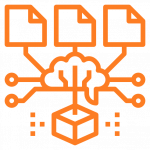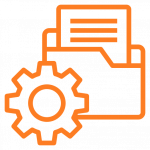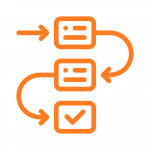Infometry Master Data Management and Implementation
Infometry Master Data Management Implementation service offers customers the ability to Strategize, Evangelize, Architect, develop and support enterprise Master Data Management (MDM) solutions. Our Master Data Management is an end-to-end solution that augments industry-leading cloud platforms with unparalleled data, deep data science expertise, and implementation excellence for faster, more precise decision-making. It consolidates and centralizes data across multiple domains to deliver the decision intelligence needed to ensure regulatory compliance, improve omni channel engagementsand drive business agility.


Our Master Data Management Solutions
Enterprise Master Data Management is crucial in streamlining maintenance and operations work and requires a process for data cleansing and sustainment. Our Master Data solution is the only MDM solution that uses technology to provide a standardized taxonomy, with all cleansing and sustainment being done as a subscription service.

Data Modeling
Infometry ensures product data modelling stays as flexible as possible, enabling a PIM and MDM to grow with your organization.
Data Management
With context-sensitive drag & drop operations and a web-based user interface, Infometry makes working with product information more efficient.


Digital Asset Management
Infometry seamlessly integrates full-featured digital asset management to integrate, manage, and relate images, documents, graphics, audio and video.
Workflow Management
Infometry boosts accuracy and productivity by establishing clearly defined business processes and standardized editorial workflows.


Data Quality Management
Infometry offers high-quality clean, and trusted data with enterprise-level data quality and data governance that scales.
Apps/Data Integration Management
Infometry lets you take charge of data integration through easy import and export of data between Infometry and external systems.

Benefits of Master Data Management
With increasing volumes of data and growing demand, managing your master data is now more critical than ever. Your business can reach new heights by using the right MDM solution and a comprehensive MDM strategy.
- Provide a unified Single Customer View of your data assets
- Boost efficiency and effectiveness
- Enhance relationships and services with customers
- Provide data more readily available for analysis
- Provide a competitive advantage with a leaner, more agile approach
- Strengthen decision-making, fueled by accurate reporting
- Prevent developing unnecessary, costly workarounds
- Increase confidence in your data
Why Choose us?
With a dedicated enterprise data management service, Infometry Data Architects have extensive experience delivering MDM solutions for Hi-Tech, Life Science, Retail and Manufacturing customers.

- Completely flexible data models handle most complex data.
- Enrich any master data record across any data domain.
- Easily manage millions of records with thousands of attributes.
- Deployment on both on-premise and cloud infrastructure.
- Our MDM software solution can automate any updates throughout the lifetime of the database.
Contact us to Manage Your Master Data Across key Domains
Frequently Asked Questions
Master Data Management (MDM) is collecting, consolidating, and maintaining consistent and accurate information about a specific set of core entities, such as customers, products, suppliers, and locations. MDM aims to ensure that an organization’s various systems and databases have a single, accurate, and up-to-date version of master data.
For example, a retail company might use MDM to ensure that all of its point-of-sale systems, customer relationship management systems, and inventory management systems have the same customer information. This would ensure that when a customer purchases at one of the company’s stores, their purchase history and contact information would be automatically updated in all of the company’s systems.
In the context of ETL (Extract, Transform, Load), master data refers to the specific set of core entities being collected, consolidated, and maintained in a master data management system. These entities typically include information about customers, products, suppliers, and locations and are used as a reference point for other data in the organization’s systems.
In the ETL process, master data is extracted from numerous sources, such as transactional systems and external databases. This data is then transformed to ensure that it is consistent, accurate, and loaded into the master data management system. This system serves as a “single source of truth” for the organization’s master data, and it is used to populate other systems and databases with the correct information.
For example, in an ETL process for a retail company, customer data from various point-of-sale systems and customer relationship management systems is extracted, transformed to ensure consistency and accuracy, and loaded into the master data management system. This system then ensures that all of the company’s designs have the same, up-to-date customer information.
Several types of Master Data Management (MDM) are commonly used, each with its specific features and use cases. These include:
Customer MDM:This type of MDM focuses on managing and maintaining consistent and accurate information about customers, such as contact information, purchase history, and demographic data.
Product MDM: This type of MDM focuses on managing and maintaining consistent and accurate information about products, such as product descriptions, pricing, and inventory levels.
Location MDM: This type of MDM focuses on managing and maintaining consistent and accurate information about physical locations, such as addresses and contact information for stores, warehouses, and distribution centers.
Supplier MDM: This type of MDM focuses on managing and maintaining consistent and accurate information about suppliers, such as contact information and product offerings.
Technical MDM: This type of MDM focuses on managing and maintaining consistent and accurate information about technological systems and data, such as system configurations and data schemas.
Hierarchical MDM: This type of MDM focuses on managing and maintaining consistent and accurate hierarchical relationships between entities, such as parent-child relationships between products or customers.
Reference data MDM: This type of MDM focuses on managing and maintaining consistent and accurate reference data, such as lists of valid values for specific fields or codes.
It’s worth noting that some organizations may use a combination of these different types of MDM, depending on their specific needs and requirements.
In the context of an Enterprise Resource Planning (ERP) system, master data refers to the specific set of core entities used to support the various functional areas of the system, such as finance, manufacturing, supply chain, and human resources. These entities typically include information about customers, products, suppliers, and locations and are used as reference points for other data in the ERP system.
The master data in an ERP system is typically stored in a centralized database, which is used to populate other databases and applications within the ERP system. This ensures that all the different functional areas of the ERP system have access to exact, accurate and up-to-date information.
Examples of master data in an ERP system include:
- Customers:Information about customers such as name, address, and contact details
- Products: Information about products such as name, description, and pricing
- Suppliers: Information about suppliers, such as name, contact details, and product offerings
- Locations: Information about physical locations such as warehouses, stores and distribution centers
ERP systems often provide a Master Data Management feature to manage and maintain Master Data. This feature enables administrators to create, edit and delete master data records and establish relationships between different types of master data, ensuring data quality and consistency throughout the ERP system.


